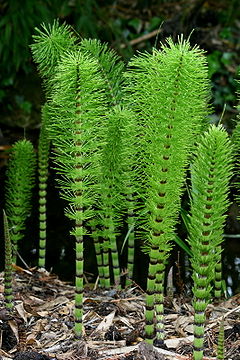(Shavegrass, Scouring Rush)--- (Equisetum arvense)
The name "horsetail", often used for the entire group, arose because the branched species somewhat resemble a horse's tail. Similarly, the scientificname Equisetum derives from the Latin equus ("horse") + seta ("bristle").
 |
| "Candocks" of the Great Horsetail, showing whorls of branches and the tiny dark-tipped leaves |
 |
| "Candocks" of the Great Horsetaill , showing whorls of branches and the tiny dark-tipped leaves |
 |
| Water horsetail The water horsetail (Equisetum fluviatile), also known as the Swamp Horsetail, is a perennial horsetail that commonly grows in dense colonies along freshwater shorelines or in shallow water, growing in ponds, swamps, ditches, and other sluggish or still waters with mud bottoms. |
 |
Field horsetail |
 |
Field horsetail |
Properties: Astringent,diuretic, lithotriptic, emmenagogue, galactagogue, nutritive, vulnerary.
What it affects: Kidneys, blood heart, and lungs
Preparation and amount:
Infusion: Steep 45 min. and take a mouthful 4 x a day or 1-2 cups daily.
Decoction: Simmer 5-15 min. and drink2 oz. 3-4 x a day
Tincture: Drink 5-30 drops 3-4 x a day.
Fluid extract: Drink5 drops 3-4 x a day.
Powder: drink 5-10 #0 capsules (30-60 grains) 3-4 x a day.
Purposes:
Internally, shavegrass is a reliable diuretic and used for all urinary disorders. Drink a decoction of 1 cup 2-3 times a day or 2 tbsp every hour. The early settlers use shavegrass as a diuretic in kidney problems and dropsy. It is specific, not only for urine retention, but for internal bleeding. it stops bleeding by helping to coagulate the blood.
Shavegrass can be used for skin and eye conditions, and is good for glandular swelling and discharge of pus.It clears fever, release nervous tension, and calms an overactive liver. It strengthens the heart and lungs and removes gravel from the bladder and kidneys. Fractured bones heal more quickly when shavegrass is taken. The Chinese use it as a healing eyewash. It can also be used for bed wetting, gallbladder diseases, skin diseases, edema, and spitting of blood. Used it for muscle cramps and spasms.It is used for bone diseases, including osteoporosis and rickets.
Early settlers used shavegrass to scour their pots and pans, hence its other name. Because it is ridged with silica, it is an outstanding scouring pad. Fine cabinetmakers use it for polishing wood finishes.
Externally, a fomentation can be placed on bleeding wounds, ulcers, and burns.
Note: Early spring shavegrass is the best to use.
Warning: Excessive use of shavegrass will irritate the kidneys and intestines; so only take it infrequently and in small doses for a short time. After 2-3 weeks, do not use it for a week. Then the treatment can be repeated. Continue use interferes with the absorption of thiamine (vitamin B1)
Plant Description:
Horsetail is a very primitive perennial plant with dark-green hollow, jointed or segmented stems 1/4 to 1/2 inch thick with no true leaves. Stems may be singular or have whorls of branches. Only single stems produce the cone-shaped spore producing body at the tip. Horsetails can be standing in water or in wet areas. Horsetail stems contain silicon crystals (i.e. sand) embedded in its tissue. This gritty texture gives it a common name of “scouring rush”.
Shavegrass can be used for skin and eye conditions, and is good for glandular swelling and discharge of pus.It clears fever, release nervous tension, and calms an overactive liver. It strengthens the heart and lungs and removes gravel from the bladder and kidneys. Fractured bones heal more quickly when shavegrass is taken. The Chinese use it as a healing eyewash. It can also be used for bed wetting, gallbladder diseases, skin diseases, edema, and spitting of blood. Used it for muscle cramps and spasms.It is used for bone diseases, including osteoporosis and rickets.
Early settlers used shavegrass to scour their pots and pans, hence its other name. Because it is ridged with silica, it is an outstanding scouring pad. Fine cabinetmakers use it for polishing wood finishes.
Externally, a fomentation can be placed on bleeding wounds, ulcers, and burns.
Note: Early spring shavegrass is the best to use.
Warning: Excessive use of shavegrass will irritate the kidneys and intestines; so only take it infrequently and in small doses for a short time. After 2-3 weeks, do not use it for a week. Then the treatment can be repeated. Continue use interferes with the absorption of thiamine (vitamin B1)
Plant Description:
Horsetail is a very primitive perennial plant with dark-green hollow, jointed or segmented stems 1/4 to 1/2 inch thick with no true leaves. Stems may be singular or have whorls of branches. Only single stems produce the cone-shaped spore producing body at the tip. Horsetails can be standing in water or in wet areas. Horsetail stems contain silicon crystals (i.e. sand) embedded in its tissue. This gritty texture gives it a common name of “scouring rush”.
No comments:
Post a Comment